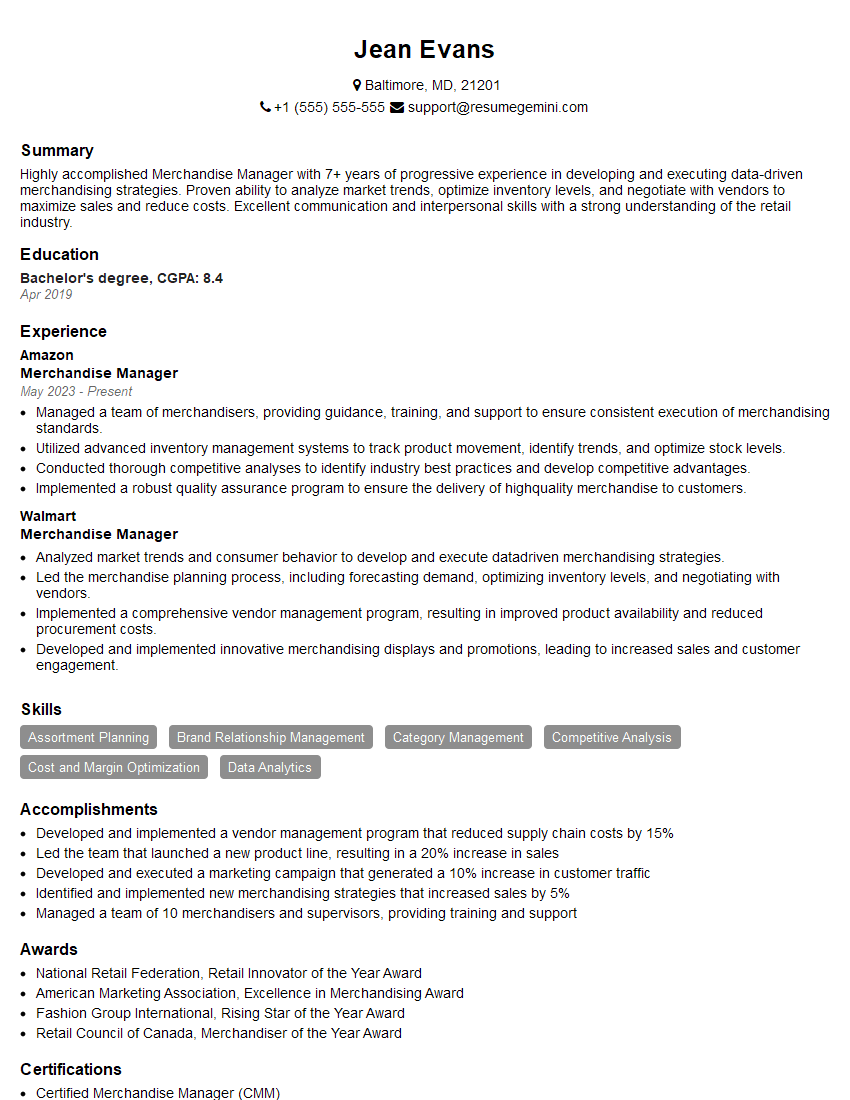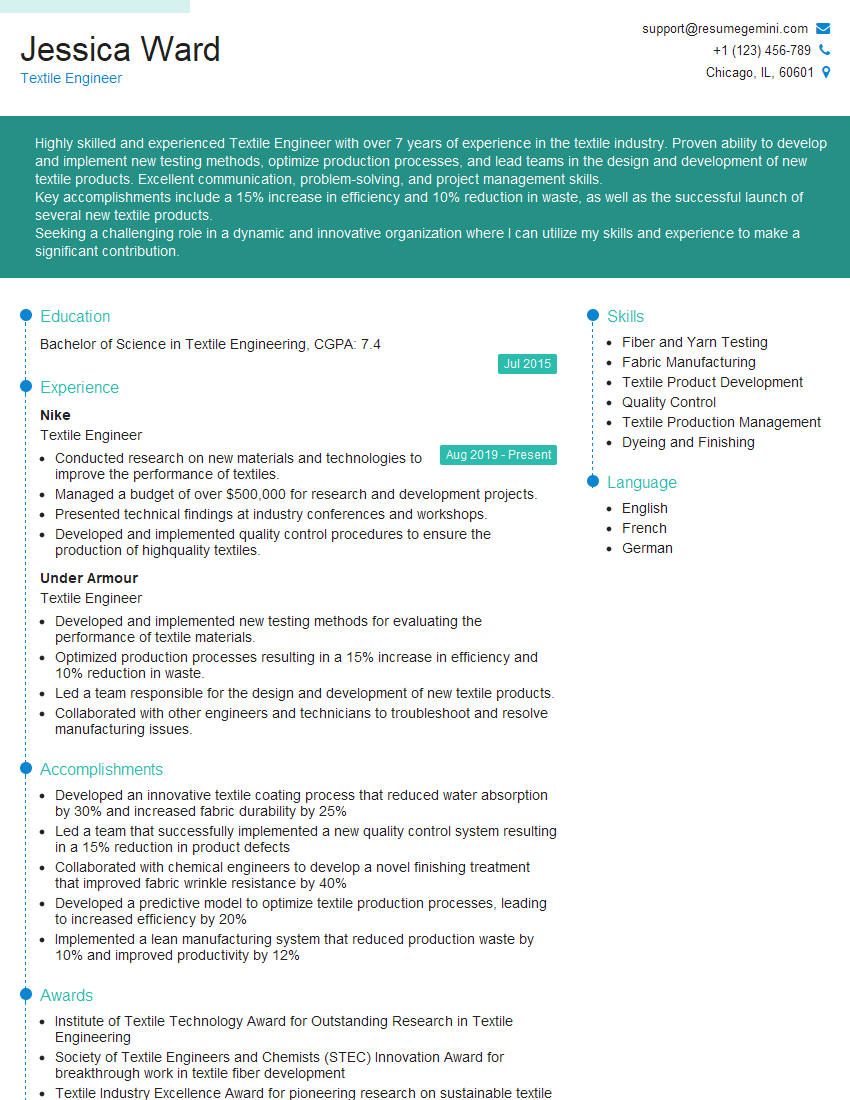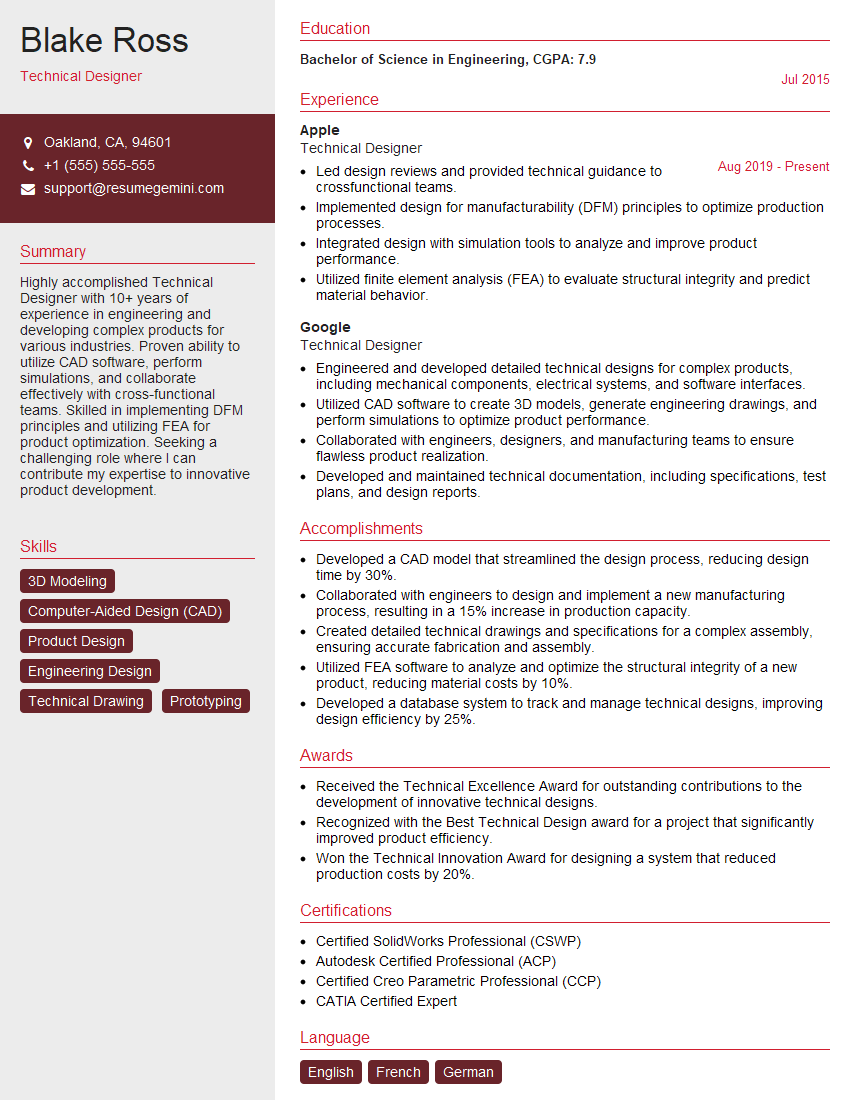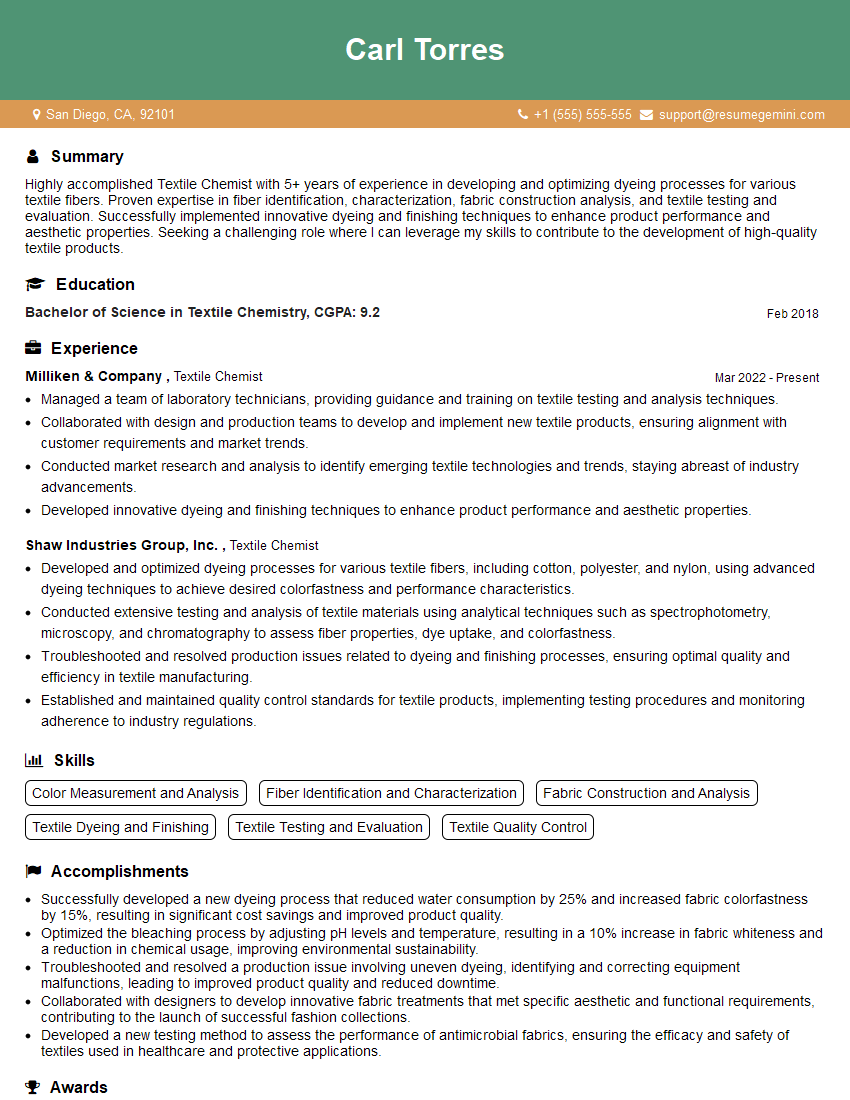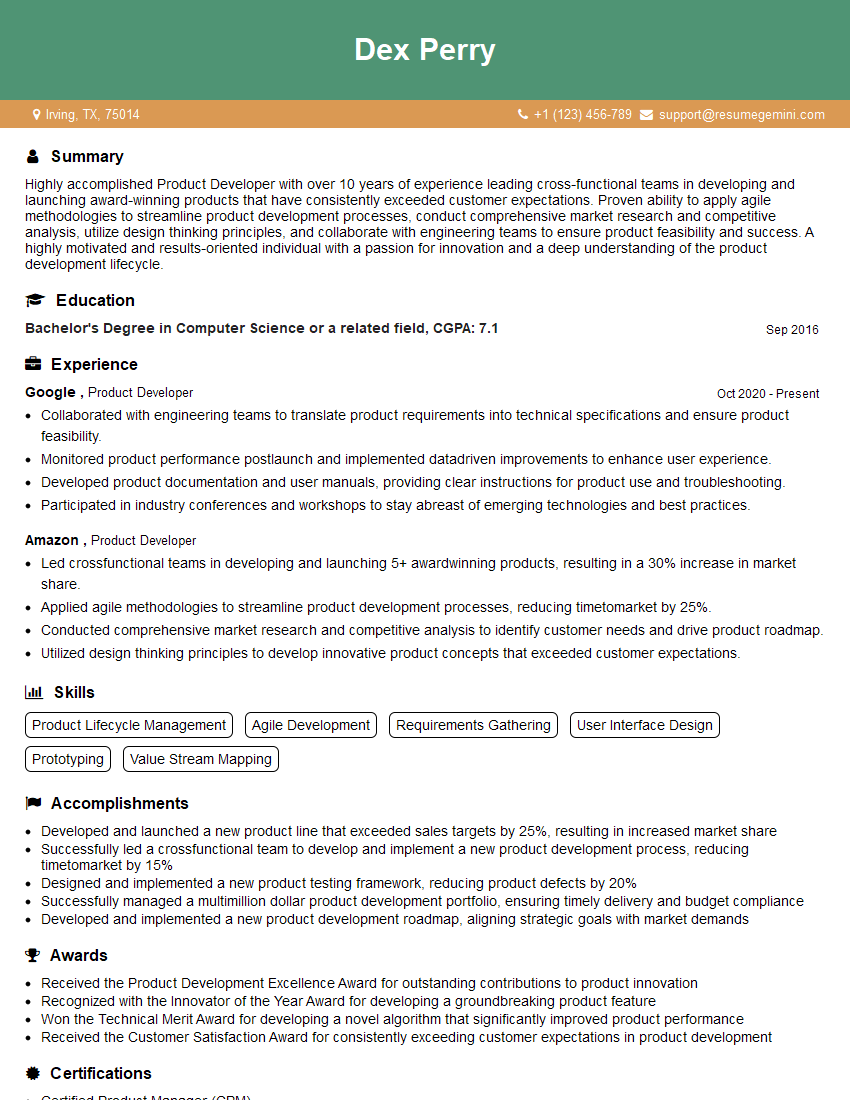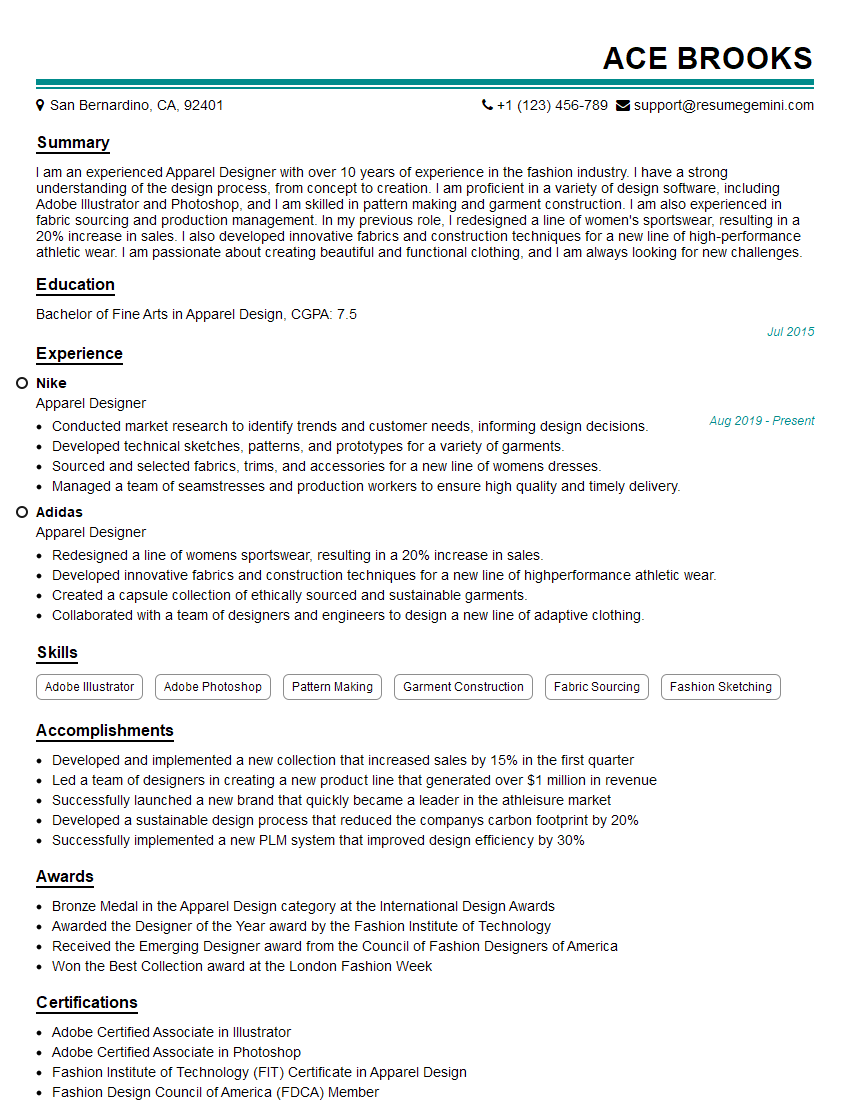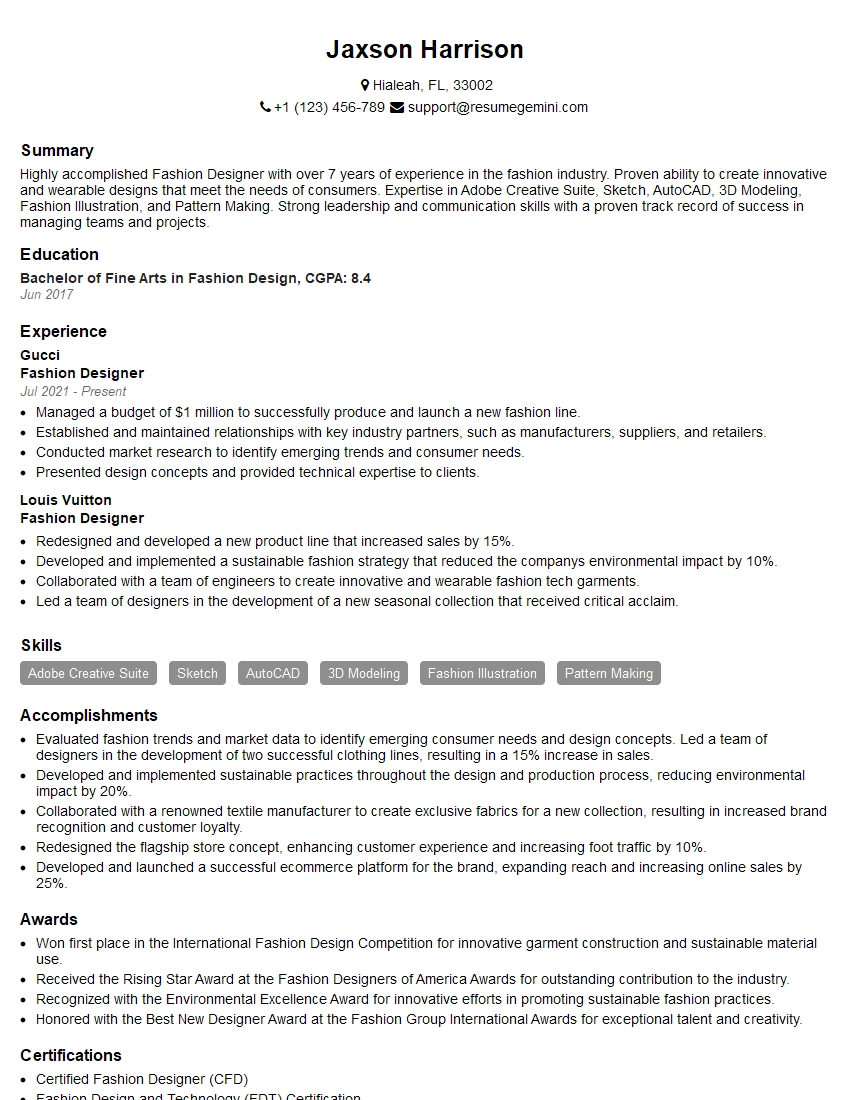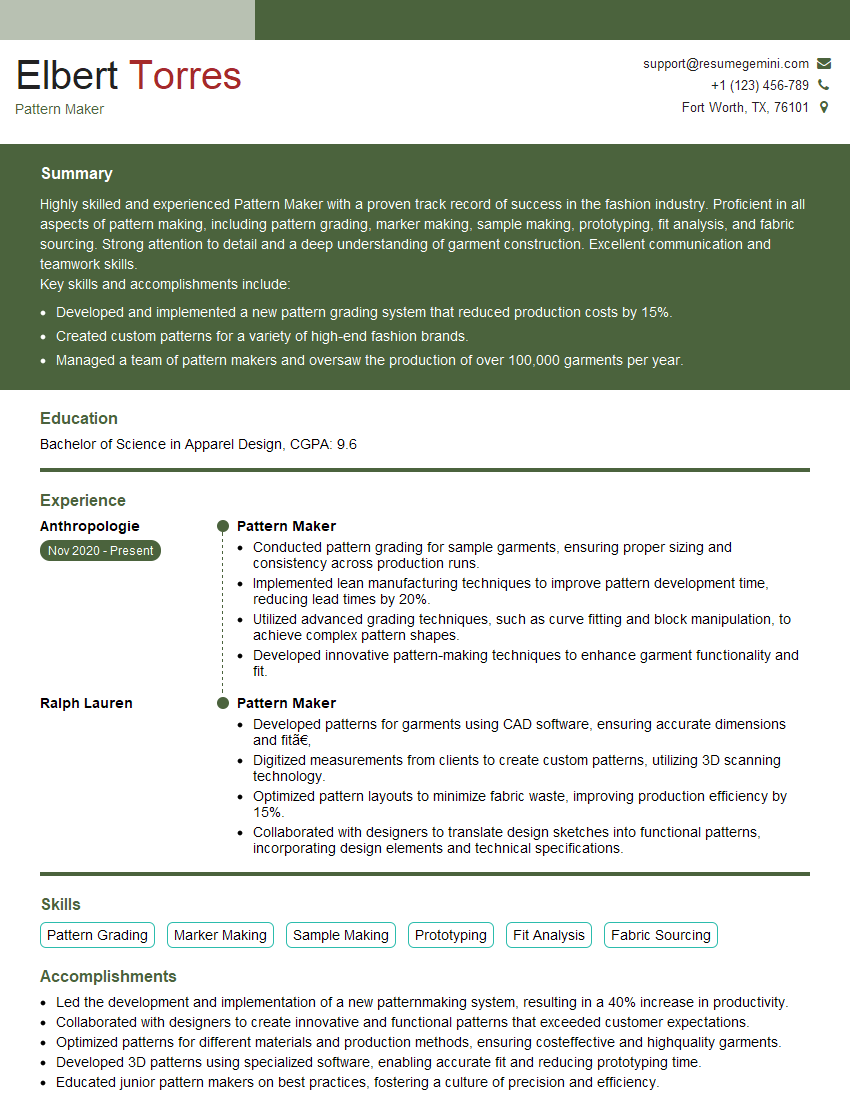Preparation is the key to success in any interview. In this post, we’ll explore crucial Fabric Types interview questions and equip you with strategies to craft impactful answers. Whether you’re a beginner or a pro, these tips will elevate your preparation.
Questions Asked in Fabric Types Interview
Q 1. Explain the difference between natural and synthetic fibers.
The fundamental difference between natural and synthetic fibers lies in their origin. Natural fibers are derived from plants or animals. Think of the soft cotton from a cotton plant, the warm wool from a sheep, or the luxurious silk from a silkworm. These fibers possess unique properties inherent to their source. Synthetic fibers, on the other hand, are created artificially through chemical processes. Polyester, nylon, and acrylic are prime examples. Their properties are engineered to achieve specific characteristics, making them versatile for various applications. The choice between natural and synthetic fibers often depends on factors like desired texture, durability, cost, and environmental impact.
Q 2. Describe the properties of cotton, wool, silk, and linen.
Let’s explore the properties of four key natural fibers:
- Cotton: A plant-based fiber known for its softness, breathability, and absorbency. It’s relatively inexpensive and widely used in clothing and home textiles. However, it can wrinkle easily and shrink when exposed to high heat.
- Wool: An animal fiber from sheep, wool is prized for its warmth, elasticity, and moisture-wicking properties. It’s naturally water-resistant and provides excellent insulation. However, it can be more expensive than cotton, and care needs to be taken to prevent felting (matting).
- Silk: A luxurious animal fiber produced by silkworms. Silk is exceptionally smooth, lustrous, and drapes beautifully. It’s known for its hypoallergenic nature and ability to regulate temperature. Its delicate nature and higher cost make it a more specialized fiber.
- Linen: A plant-based fiber derived from flax. Linen is strong, durable, and known for its excellent breathability and absorbency. It’s highly resistant to wrinkles but can be prone to creasing. Its crisp texture and luxurious feel make it a popular choice for high-end garments and household items.
Q 3. What are the advantages and disadvantages of using polyester?
Polyester is a versatile synthetic fiber with many advantages and disadvantages:
- Advantages: Durable, wrinkle-resistant, water-resistant, quick-drying, inexpensive, and relatively easy to care for. These properties make it ideal for sportswear, outdoor clothing, and upholstery.
- Disadvantages: Can feel less soft than natural fibers, not as breathable, prone to static cling, and can retain odors. Its sustainability is also a concern due to its petroleum-based origin and the environmental impact of its production.
For instance, the wrinkle resistance of polyester makes it perfect for travel clothing, but its lack of breathability might make it unsuitable for hot climates.
Q 4. How does the weave of a fabric affect its drape and durability?
The weave of a fabric significantly influences both its drape and durability. Drape refers to how the fabric falls and hangs. Durability refers to its resistance to wear and tear. A tightly woven fabric, like a densely packed plain weave, will generally have a stiffer drape and higher durability. A loosely woven fabric, such as a sheer voile, will have a softer, more fluid drape but less durability. The type of yarn used and its thickness also plays a role. Thicker yarns create a heavier, less draping fabric, but might be more durable. Think of a heavy canvas vs. a fine silk chiffon – their weaves and yarn weight drastically change their properties.
Q 5. Compare and contrast twill, satin, and plain weave fabrics.
Let’s compare three common weaves:
- Plain Weave: The simplest weave, with yarns interlacing in an over-under pattern. It creates a relatively stable, durable fabric, but can lack visual interest. Think of your basic cotton t-shirt.
- Twill Weave: Creates diagonal lines on the fabric surface due to a floating pattern of the warp yarns over multiple weft yarns. This results in a stronger, more durable fabric with a characteristic diagonal texture. Denim is a classic example.
- Satin Weave: Characterized by long floats of warp yarns over multiple weft yarns, creating a smooth, lustrous surface with a beautiful sheen. Satin weaves are less durable than twill or plain weaves due to the long, floating yarns, but their luxurious feel is highly desirable.
The differences in weave structure directly translate to differences in the fabric’s feel, appearance, and durability.
Q 6. Explain the concept of fabric weight and its impact on garment construction.
Fabric weight, typically measured in ounces per square yard (oz/sq yd), significantly impacts garment construction. Heavier fabrics (e.g., heavyweight denim, canvas) require stronger seams and more robust construction techniques to withstand stress. They are typically used for outerwear or items requiring substantial durability. Lighter fabrics (e.g., chiffon, voile) require finer needles and less dense stitching to avoid damage. The choice of fabric weight influences the garment’s overall structure, drape, and suitability for different seasons and purposes.
For example, a lightweight cotton would be ideal for a summer dress, while a heavier wool would be more suitable for a winter coat. The weight will also determine the type of pattern and design that works best for the fabric. A heavier fabric might not drape well in a flowy design.
Q 7. What are some common fabric finishes and their purposes?
Fabric finishes are treatments applied to modify the fabric’s properties. Some common finishes and their purposes include:
- Mercerization: Treating cotton with alkali to increase its luster, strength, and dye affinity.
- Sanforizing: Pre-shrinking cotton fabric to minimize shrinkage after washing.
- Water-repellent finishes: Applying coatings to make fabric resistant to water without hindering breathability.
- Flame-retardant finishes: Treating fabrics to reduce flammability.
- Anti-microbial finishes: Adding treatments to inhibit the growth of bacteria and reduce odors.
These finishes enhance the fabric’s performance, durability, and aesthetic appeal, adapting it for specific applications. For example, a water-repellent finish is crucial for outdoor jackets, while antimicrobial finishes are beneficial in sportswear to prevent odor build-up.
Q 8. How do you identify different fabric blends?
Identifying fabric blends requires a multi-sensory approach combining visual inspection, touch, and sometimes even burning a small, inconspicuous sample. Visually, look at the fiber characteristics – is it shiny (like silk or some synthetics), matte (like cotton or linen), or a combination? Feel the fabric’s texture – is it smooth, rough, soft, stiff? Does it have a particular hand (the way it feels to the touch)?
A crucial step is the burn test (though always proceed cautiously!). Natural fibers like cotton, linen, wool, and silk burn differently than synthetics like polyester, nylon, or rayon. Cotton burns relatively quickly with a smell of burning paper, leaving behind ash. Polyester melts, forming a hard bead. This test helps distinguish between blends. For example, if a fabric burns partially like cotton and partially melts like polyester, it’s likely a cotton/polyester blend. However, this test shouldn’t be your sole method. Always check the care label for a definitive blend percentage.
- Visual Inspection: Examine the weave structure, luster, and overall appearance.
- Touch Test: Assess texture, drape, and hand feel.
- Burn Test: Carefully burn a small sample to observe burning characteristics and smell (use caution!).
- Label Check: Check the care label for accurate composition information.
For instance, a soft, slightly shiny fabric with a good drape might visually appear to be silk but could be a silk/polyester blend to increase durability. The burn test would confirm the presence of the synthetic fiber.
Q 9. Describe the process of fabric testing and quality control.
Fabric testing and quality control is a critical process ensuring the final product meets the required standards. It involves a series of tests performed at various stages of production, from raw materials to the finished garment. These tests assess various aspects including strength, durability, colorfastness, shrinkage, and wrinkle resistance.
The process typically involves:
- Fiber Testing: Analyzing the raw fibers for length, strength, fineness, and impurities.
- Yarn Testing: Assessing yarn strength, evenness, and count (number of fibers).
- Fabric Testing: Evaluating fabric properties such as tensile strength, tear strength, abrasion resistance, shrinkage, colorfastness, and drape.
- Garment Testing: Evaluating the finished garment for dimensional stability, seam strength, and overall quality.
Specific tests include:
- Tensile Strength Test: Measures the fabric’s resistance to pulling forces.
- Abrasion Resistance Test: Evaluates the fabric’s ability to withstand rubbing and wear.
- Colorfastness Test: Assesses the fabric’s resistance to fading from washing, light exposure, and perspiration.
- Shrinkage Test: Determines the fabric’s tendency to shrink after washing.
Quality control involves regular inspections at each stage. Samples are taken and tested to ensure consistency and adherence to standards. Any defects are identified and addressed to maintain quality throughout the entire production process. Failing to properly assess quality at each phase could result in issues such as inconsistent garment sizing, poor durability, and ultimately, customer dissatisfaction.
Q 10. What are the key factors to consider when selecting a fabric for a specific garment?
Selecting the right fabric for a garment is a crucial design decision. Several factors need consideration:
- End Use: The garment’s intended purpose dictates the fabric choice. A swimsuit requires a quick-drying, chlorine-resistant fabric unlike a winter coat which needs warmth and water resistance.
- Fiber Content: Natural fibers (cotton, wool, silk, linen) offer breathability and comfort but may require more care. Synthetic fibers (polyester, nylon, rayon) provide durability, wrinkle resistance, and are often less expensive but may lack breathability.
- Weight: Fabric weight affects drape and warmth. Lightweight fabrics are suitable for summer dresses, while heavier fabrics are better for coats.
- Drape: How the fabric hangs and falls influences the garment’s silhouette. A stiff fabric creates a structured look, while a flowing fabric creates a softer, more relaxed look.
- Texture: The fabric’s surface texture (smooth, rough, bumpy) contributes to the overall aesthetic and feel.
- Cost: Fabric cost is a significant factor, particularly when producing garments at scale.
- Care Instructions: The fabric’s care instructions must be considered for ease of maintenance and consumer expectations.
For example, designing a performance athletic shirt calls for moisture-wicking fabric with good breathability, perhaps a blend of polyester and elastane. Conversely, a formal evening gown may require a luxurious fabric like silk or a high-quality blend, emphasizing drape and luxurious feel.
Q 11. Explain the impact of fiber content on fabric shrinkage.
Fiber content significantly impacts fabric shrinkage. Natural fibers like cotton and wool have a higher tendency to shrink than most synthetics. This is because natural fibers are composed of cellulose (cotton) or protein (wool) molecules that absorb moisture, causing them to swell and contract upon exposure to heat and moisture during washing or drying.
Cotton’s shrinkage depends on factors like fiber length and spinning process. Long-staple cotton is less likely to shrink than short-staple. Wool’s shrinkage is influenced by the type of wool and the processing. Superwash wool treatments reduce shrinkage.
Synthetic fibers like polyester, nylon, and acrylic tend to shrink less because they are less hydrophilic (water-absorbing) than natural fibers. However, even synthetics can exhibit some dimensional changes with improper washing.
Blends of natural and synthetic fibers exhibit varying shrinkage rates depending on the fiber composition. A higher percentage of natural fibers will result in greater shrinkage potential.
Pre-shrinking fabric before garment construction is a common method to minimize shrinkage issues in the finished product.
Q 12. How does fabric drape affect the design and fit of a garment?
Fabric drape significantly affects garment design and fit. Drape refers to the way a fabric hangs and flows when not supported. It’s influenced by the fiber content, weave structure, and fabric weight. A fabric’s drape dictates the overall silhouette and creates visual appeal.
Stiff fabrics, like those with a high percentage of linen or tightly woven cotton, create structured garments with well-defined shapes. Think of a crisp, tailored shirt or a structured blazer. These fabrics hold their shape and create sharp lines.
Soft, flowing fabrics, like silk, rayon, or some knits, create softer, more fluid silhouettes. They drape easily and gracefully, leading to designs such as flowing dresses or draped tops. The design would emphasize the fabric’s ability to create movement and softness.
Medium-drape fabrics, like many cotton poplins or gabardines, offer a balance between structure and fluidity. They are versatile and suitable for many styles.
Understanding a fabric’s drape is essential to choosing appropriate patterns, selecting proper construction techniques, and envisioning the final garment’s look and feel. For example, a tightly woven fabric would need a more structured pattern to properly highlight its characteristics. Ignoring drape can result in a garment that doesn’t drape properly, appearing ill-fitting or awkward.
Q 13. Discuss the sustainability considerations related to various fabric types.
Sustainability is a growing concern in the textile industry. The environmental impact of various fabric types needs careful consideration.
Sustainable fabrics often emphasize minimal environmental impact throughout their life cycle, from raw material production to end-of-life disposal.
- Organic cotton: Grown without pesticides and synthetic fertilizers, reducing harm to the environment and farmworkers. However, organic cotton production can sometimes require more land and water.
- Hemp: A durable and fast-growing crop requiring minimal water and pesticides. It offers good breathability and strength.
- Linen: Made from flax, a sustainable crop that requires less water than cotton. Linen is strong, durable, and biodegradable.
- Tencel (Lyocell): A sustainable cellulose fiber produced using a closed-loop system that minimizes water and solvent use.
- Recycled polyester: Made from recycled plastic bottles, reducing landfill waste. However, the recycling process still requires energy.
- Bamboo: A rapidly renewable resource, but processing often involves harsh chemicals.
Unsustainable fabrics often involve practices with a significant negative environmental impact, such as large water consumption (conventional cotton), pesticide use, or high energy consumption in production (synthetic fibers).
Choosing sustainable fabrics reduces the environmental footprint of the garment industry, but also factors such as fair labor practices and ethical sourcing should be considered to ensure a truly sustainable product.
Q 14. What are some common fabric defects and how are they identified?
Common fabric defects can significantly affect garment quality. Identifying these defects is crucial for quality control.
- Holes and breaks: Obvious defects easily detected by visual inspection.
- Weave irregularities: Loose or missing yarns, mispicks (incorrect yarn interlacing), or slubs (thickened areas) in the fabric. These can be identified through visual inspection and sometimes need magnification.
- Stains and discoloration: Impurities or uneven dyeing affect the fabric’s appearance. Visual inspection is key.
- Shrinkage: Fabric that shrinks excessively after washing will lead to ill-fitting garments. This needs standardized shrinkage testing.
- Pilling: Small balls of fiber that form on the fabric surface due to abrasion. This is observed through visual inspection.
- Colorfastness issues: Fading or bleeding of color after washing or exposure to light. This requires specific testing under controlled conditions.
- Wrinkles and creases: Excessive wrinkling can affect drape and appearance. This is often assessed visually but can be quantified using specialized equipment.
Identifying defects requires careful visual inspection, sometimes supplemented by magnification, and standardized testing procedures. Understanding the cause of defects helps to improve manufacturing processes and avoid such issues in the future. For example, uneven dyeing might require adjusting the dyeing process, while excessive pilling points to a need for improved fiber selection or fabric finishing.
Q 15. Explain the difference between knitting and weaving.
Knitting and weaving are two fundamental fabric construction methods, differing significantly in their yarn arrangement and resulting fabric properties. Think of knitting as a series of interlocking loops, while weaving involves interlacing two sets of yarns at right angles.
Knitting: Uses a single yarn to create interlocking loops, forming a flexible, often stretchy fabric. Imagine a chainmail, where each link is a loop of yarn. This process is done using needles or specialized knitting machines.
Weaving: Employs two sets of yarns – the warp (lengthwise) and weft (crosswise) – interlaced at right angles to create a more stable and less stretchy fabric. Picture a basket, where the warp and weft threads are woven over and under each other.
The differences translate to different fabric characteristics. Knits tend to be more drapey and have more give, while woven fabrics often exhibit greater strength and durability. For example, a jersey t-shirt is knit, while a denim pair of jeans is woven.
Career Expert Tips:
- Ace those interviews! Prepare effectively by reviewing the Top 50 Most Common Interview Questions on ResumeGemini.
- Navigate your job search with confidence! Explore a wide range of Career Tips on ResumeGemini. Learn about common challenges and recommendations to overcome them.
- Craft the perfect resume! Master the Art of Resume Writing with ResumeGemini’s guide. Showcase your unique qualifications and achievements effectively.
- Don’t miss out on holiday savings! Build your dream resume with ResumeGemini’s ATS optimized templates.
Q 16. Describe the properties of different types of knit fabrics (e.g., jersey, rib, interlock).
Various knit fabrics possess unique properties owing to their stitch structures and yarn composition.
Jersey: This is a basic knit structure, characterized by its single layer of loops, creating a soft, drapey fabric with excellent stretch and recovery. Think of your typical t-shirt fabric. It’s prone to curling at the edges and can be somewhat sheer.
Rib: This knit features alternating knit and purl stitches, resulting in vertical ribs that provide more structure and stability compared to jersey. It’s less stretchy but offers better edge retention. Ribbed cuffs on sweaters are a prime example.
Interlock: This is a double-layered knit with interlocking loops, making it thicker, more durable, and less prone to curling than jersey. It’s often used in higher-quality t-shirts and underwear due to its stability and smoother surface.
The choice of knit fabric depends on the desired garment properties. For instance, jersey is ideal for comfortable, flowing garments, while rib knit is preferable for items needing more shape retention, and interlock is suitable for durable, high-quality apparel.
Q 17. What are the key characteristics of non-woven fabrics?
Non-woven fabrics are created by bonding or entangling fibers together, rather than knitting or weaving them. This method offers a diverse range of properties and applications.
Key Characteristics: They lack the inherent strength and durability of woven or knit fabrics. However, they offer advantages like being less expensive, quicker to manufacture, and often exhibiting better breathability and absorbency. They can also be made from recycled materials.
Methods: Various methods like needle punching, thermal bonding, and hydroentangling are used to consolidate fibers. For example, needle punching mechanically interlocks fibers, creating a strong structure, while thermal bonding uses heat and pressure to fuse fibers together.
Examples of non-woven fabrics include felt, wipes, and many medical and industrial applications. Their versatility makes them suitable for applications where cost-effectiveness and specific functional properties are prioritized over high tensile strength.
Q 18. Explain the concept of fabric hand and its importance in garment selection.
Fabric hand refers to the tactile qualities of a fabric – its feel, drape, and texture. It’s essentially how a fabric feels to the touch. This includes factors like softness, smoothness, stiffness, crispness, and suppleness.
Importance in Garment Selection: Fabric hand significantly impacts garment selection and wearer comfort. A soft, drapey fabric like silk is perfect for elegant evening wear, while a crisp, sturdy fabric like cotton canvas is ideal for durable workwear. Considering the fabric hand ensures the garment feels comfortable and appropriate for its intended use. For example, a rough hand wouldn’t be suitable for delicate lingerie, while a smooth, cool hand would be inappropriate for heavy-duty work clothes.
Q 19. How does fabric colorfastness affect garment care?
Fabric colorfastness refers to a fabric’s resistance to color fading or bleeding due to washing, light exposure, or rubbing. High colorfastness means the color will stay vibrant and true for a longer time.
Effect on Garment Care: Colorfastness directly influences garment care instructions. Fabrics with poor colorfastness require special care, such as hand-washing in cold water and air-drying to prevent color bleeding or fading. Garments with good colorfastness offer more flexibility in washing and drying, making them easier to care for. The care label should always reflect the colorfastness of the fabric.
Q 20. Discuss the role of fabric flammability in safety regulations.
Fabric flammability is a crucial safety aspect, especially in clothing and furnishings. Highly flammable fabrics pose significant fire hazards, potentially causing severe burns or even fatalities.
Role in Safety Regulations: Safety regulations, like those from the Consumer Product Safety Commission (CPSC), often mandate flammability testing and standards for fabrics used in clothing and other consumer products. These regulations define flammability limits and set requirements for flame-retardant treatments. For instance, children’s sleepwear often has strict flammability regulations to minimize fire risks.
Q 21. What are the different methods used for dyeing fabrics?
Various methods are used to dye fabrics, each offering specific advantages and resulting in different color depths and fastness.
Vat dyeing: This method is used for deep, durable colors on cellulosic fibers (like cotton). It involves applying an insoluble dye, then reducing it to a soluble form, allowing it to penetrate the fibers. Afterwards, the dye is re-oxidized, making it insoluble again, trapping the color within the fibers. This process leads to excellent colorfastness.
Reactive dyeing: Another method for cellulosic fibers, reactive dyes form a chemical bond with the fiber, resulting in very good wash-fastness.
Direct dyeing: This is a simpler, less expensive method, suitable for cellulosic fibers. The dye is directly applied to the fiber without any chemical modification, providing adequate but less colorfast results than vat or reactive dyeing.
Disperse dyeing: Used mainly for synthetic fibers like polyester, disperse dyes are insoluble in water and are dispersed into the fiber with the help of a carrier or through high-temperature dyeing. The resulting colorfastness is typically moderate.
Acid dyeing: Applied to animal fibers like wool and silk, this method involves using acidic dyes that attach well to the fiber. It produces vibrant colors with good to excellent colorfastness.
The choice of dyeing method depends on the fiber type, desired colorfastness, cost considerations, and the intended end-use of the fabric.
Q 22. Explain the process of printing designs onto fabrics.
Printing designs onto fabrics is a multifaceted process involving various techniques, each suited to different fabrics and desired outcomes. The core principle involves transferring a design onto fabric using ink or dye.
- Screen Printing: A stencil is used to block ink from certain areas, allowing it to pass through to the fabric in the desired pattern. This is cost-effective for large runs and produces bold, vibrant prints. Think of those classic band t-shirts.
- Digital Printing: This method uses inkjet technology to directly print onto fabric, offering great detail and allowing for customizable designs and small batch production. It’s ideal for unique, personalized apparel or home decor.
- Rotary Screen Printing: This high-speed technique uses a cylindrical screen that rotates, printing continuous designs onto long lengths of fabric. This is often used for large scale production of textiles for things like bedding or upholstery.
- Heat Transfer Printing: A design is printed onto transfer paper, then applied to the fabric using heat and pressure. This method is easy and works well for smaller runs, commonly used for creating personalized gifts or t-shirts.
The choice of printing technique depends on factors like the type of fabric, design complexity, quantity needed, and budget.
Q 23. How do you determine the appropriate fabric for a specific end-use?
Selecting the right fabric for a specific end-use requires careful consideration of its properties. Think about the garment’s intended function, the wearer’s needs, and the overall aesthetic.
- Durability: For workwear or activewear, you’d need durable fabrics like canvas, nylon, or polyester. For delicate lingerie, a softer fabric like silk or modal would be more appropriate.
- Breathability: Cotton is a highly breathable fabric, excellent for summer clothing. Synthetic fabrics like polyester often have moisture-wicking properties, making them suitable for sportswear.
- Drape: The way a fabric hangs and falls influences garment design. Fluid fabrics like silk or rayon create elegant drapes, while stiffer fabrics like linen hold shape better.
- Comfort: Consider the hand feel of the fabric—its texture and softness. A soft, plush fabric like cashmere is luxurious but may not be ideal for outdoor activities.
- Care Instructions: Fabric choice directly impacts how easy it will be to care for the finished product. Some fabrics require special cleaning, adding to the overall cost and inconvenience.
A thorough understanding of fabric properties is crucial in making the right selection. For example, if designing a summer dress, lightweight and breathable fabrics like cotton voile or linen are preferred over heavier materials.
Q 24. Describe different methods of fabric finishing (e.g., mercerization, sanforizing).
Fabric finishing processes enhance the fabric’s appearance, performance, and durability. Here are some common methods:
- Mercerization: This treatment involves treating cotton fabric with a sodium hydroxide solution. It increases luster, strength, dye affinity, and improves its absorbency. Think of the smooth, shiny surface of high-quality cotton t-shirts.
- Sanforizing: A pre-shrinking process that minimizes shrinkage after washing. This reduces the risk of garments becoming smaller after cleaning, ensuring a consistent fit. Commonly used in denim and other woven fabrics.
- Calendering: This involves passing fabric through rollers under high pressure and heat to create a smooth, glossy surface or a specific texture. It’s used to create different finishes like high sheen or matte.
- Stonewashing: A treatment that creates a faded or worn look by tumbling the fabric with pumice stones. This is common in denim to create a vintage look.
- Water Repellent Finishes: These finishes are applied to increase a fabric’s resistance to water and stains. This is useful for outdoor garments and upholstery.
These finishing techniques significantly impact the final quality and characteristics of the fabric.
Q 25. What are some innovative fabric technologies currently being developed?
The textile industry is constantly evolving, and several innovative fabric technologies are shaping the future:
- Bio-based fabrics: These fabrics are made from renewable resources like bamboo, hemp, or seaweed, promoting sustainability. They often boast environmentally friendly production processes.
- Smart fabrics: Integrated with sensors or conductive threads, these fabrics can monitor vital signs, change color, or provide other interactive functionalities. Imagine clothing that adjusts to temperature.
- Self-cleaning fabrics: Utilizing nanotechnology, these fabrics repel dirt and stains, reducing the need for frequent washing. This leads to less water and energy consumption.
- Recycled fabrics: Utilizing recycled materials and reducing textile waste, these fabrics are environmentally responsible and reduce dependence on virgin resources.
- 3D-printed fabrics: Offering customized designs and complex structures, 3D printing is creating new possibilities in textile manufacturing.
These innovations are not only improving the functionality and sustainability of fabrics but are also changing how textiles are designed and manufactured.
Q 26. How do you assess the cost-effectiveness of different fabrics?
Assessing the cost-effectiveness of different fabrics involves considering various factors:
- Raw Material Cost: The price of the raw materials used in fabric production significantly impacts the overall cost. Natural fibers like silk or cashmere are generally more expensive than synthetic fibers.
- Production Costs: The manufacturing process itself contributes to the fabric’s cost. Complex processes or specialized machinery will likely increase the expense.
- Finishing Costs: Finishing treatments, such as mercerization or stonewashing, can add to the overall price. The more complex the treatment, the greater the cost.
- Durability and lifespan: A more durable fabric might have a higher initial cost but might last longer, thus proving cost-effective in the long run. A durable fabric reduces replacement costs.
- Transportation and Storage Costs: Transportation and storage costs need to be factored in, particularly for bulk orders.
A thorough cost analysis considering all these factors is essential to make informed decisions and optimize budget allocation.
Q 27. Discuss the importance of understanding fabric certifications (e.g., OEKO-TEX, GOTS).
Understanding fabric certifications is critical for ensuring quality, safety, and ethical sourcing. Certifications like OEKO-TEX and GOTS provide assurance to consumers and brands.
- OEKO-TEX Standard 100: This certification tests for harmful substances in textiles, ensuring that fabrics are safe for human contact. It covers a wide range of chemicals and substances. It demonstrates commitment to health and safety.
- Global Organic Textile Standard (GOTS): This certification guarantees that organic fibers are used in production and that the entire process adheres to environmental and social criteria. This promotes sustainability and ethical production methods.
- Fair Trade Certifications: These certifications ensure fair wages and working conditions for those involved in the production process. This supports ethical labor practices.
These certifications provide transparency and traceability, building trust with consumers who increasingly demand ethically and sustainably produced products.
Q 28. Explain how fabric choice influences the overall cost of garment production.
Fabric choice significantly influences the overall cost of garment production. It affects multiple stages of the process:
- Raw Material Costs: The price of fabric directly impacts the production budget. Expensive fabrics like silk or cashmere increase overall garment cost.
- Production Efficiency: Some fabrics are easier to work with than others. Difficult-to-handle fabrics might require more labor and time, thus increasing costs.
- Waste and Shrinkage: Fabrics with high shrinkage rates lead to increased material waste, raising the cost per garment.
- Finishing Costs: Certain fabrics require specialized finishes, which add to the production expense. These specialized finishes increase cost.
- Packaging and Shipping Costs: Heavier fabrics will result in higher shipping costs.
Therefore, careful fabric selection is essential to manage production costs without compromising quality or design.
Key Topics to Learn for Fabric Types Interview
- Natural Fibers: Understanding the properties (strength, drape, absorbency) of cotton, linen, silk, wool, and their suitability for different garment types and applications. Consider the impact of different weaving and knitting techniques.
- Synthetic Fibers: Exploring the characteristics (durability, elasticity, water resistance) of polyester, nylon, rayon, acrylic, and their uses in various apparel and industrial fabrics. Analyze the environmental impact and recycling potential.
- Fabric Finishes: Learning about processes like mercerization, dyeing, printing, and coating, and how they alter fabric properties (e.g., softness, wrinkle resistance, water repellency). Discuss the impact of different finishes on the final product and its performance.
- Fabric Construction: Gaining knowledge of different weave structures (plain, twill, satin), knit structures (jersey, rib), and their influence on fabric properties like drape, durability, and breathability. Be prepared to discuss the advantages and disadvantages of each construction method.
- Fabric Weight and Drape: Understanding how fabric weight and drape affect garment construction and style. Be able to discuss how these properties influence the choice of fabric for a particular design.
- Fabric Testing and Quality Control: Familiarize yourself with common fabric testing methods used to assess quality, strength, and performance characteristics. Discuss the importance of quality control in the textile industry.
- Sustainability and Ethical Sourcing: Discuss the growing importance of sustainable and ethical sourcing of fabrics. Understand the environmental impact of different fiber production methods and the role of certifications like GOTS (Global Organic Textile Standard).
Next Steps
Mastering fabric types is crucial for career advancement in the textile and fashion industries, opening doors to diverse and exciting roles. A well-crafted resume is your key to unlocking these opportunities. Building an ATS-friendly resume is essential to ensure your application gets noticed. ResumeGemini is a trusted resource to help you create a professional and impactful resume that highlights your skills and experience in fabric types. Examples of resumes tailored to Fabric Types are available to provide further guidance.
Explore more articles
Users Rating of Our Blogs
Share Your Experience
We value your feedback! Please rate our content and share your thoughts (optional).
What Readers Say About Our Blog
Hi, I represent an SEO company that specialises in getting you AI citations and higher rankings on Google. I’d like to offer you a 100% free SEO audit for your website. Would you be interested?
good
